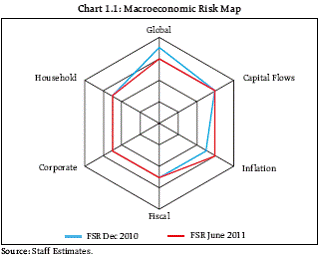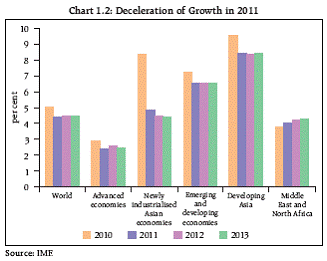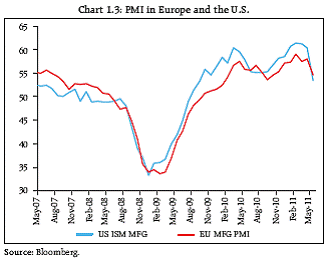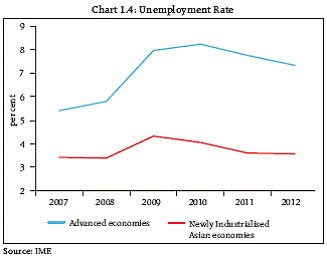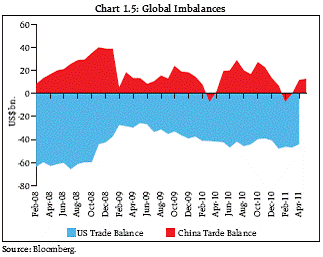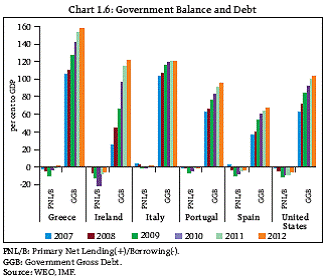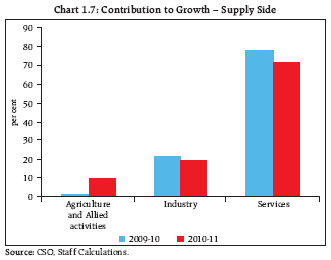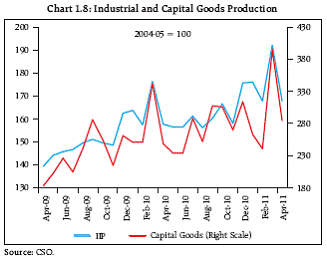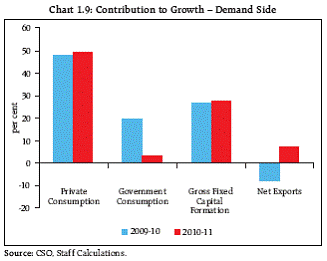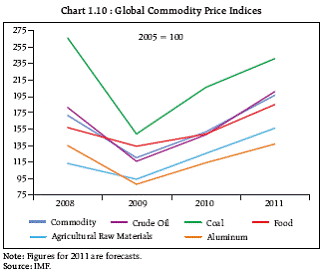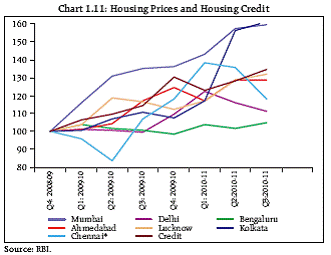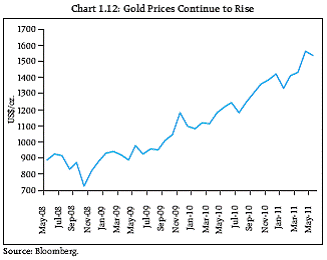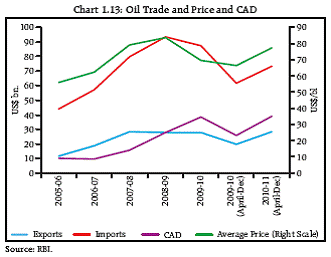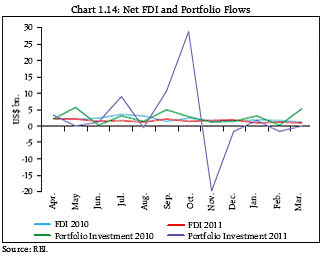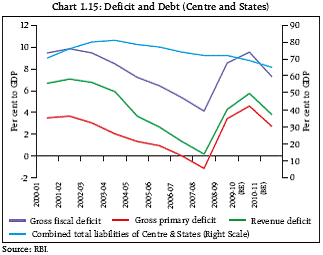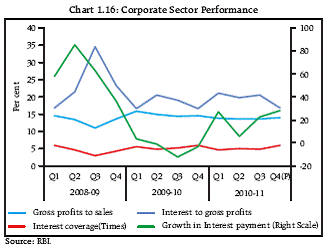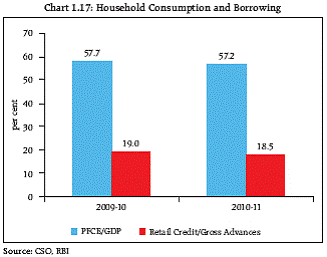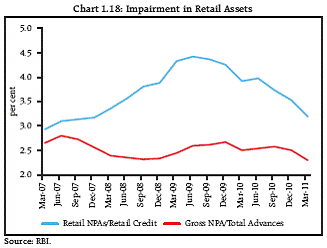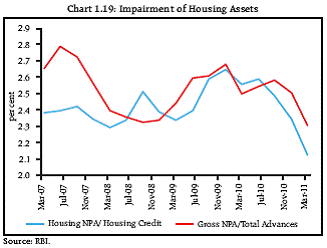 IST,
IST,
Chapter I : Macroeconomic Outlook
Improvement in macroeconomic conditions at the global level has contributed to some moderation in risks to global financial stability. However, considerable uncertainty remains. Fiscal weakness and sovereign debt problems in the euro area, high leveraging in many advanced economies, banking sector default risks prevailing in some regions, the consequences of the Japanese earthquake, persistence of MENA turmoil and continuance of high energy and commodity prices may negatively impact investors’ confidence and spending decisions of corporations and households. On the domestic front, growth is likely to moderate while inflation is likely to remain firm due to rising commodity prices. This is expected to have an adverse impact on the fiscal consolidation process. The current account deficit is likely to remain elevated due to rise in imports resulting from higher oil and commodity prices, along with challenges of financing, as global conditions increase volatility in capital flows. High input prices and interest costs may result in downward pressure on margins of corporates. The aggregate impact of moderately paced global recovery, domestic growth moderation, upside risks to inflation and higher interest rates on the financial sector is likely to remain somewhat adverse during the year. Global risks decline but risks from inflation and capital flows remain high 1.1. Since the publication of the second Financial Stability Report (FSR) of the Reserve Bank in December 2010, the signs of recovery in several advanced economies have strengthened. Some concerns regarding sovereign debt risks in the Euro Area, however, have reemerged. On balance, the global risks have improved but remain elevated. On the domestic front, decline in risks due to moderation in capital flows has been offset by the increased volatility in portfolio flows. Risks from inflation have increased since December 2010. Corporate and household risks have remained at the same levels (Chart 1.1).
Global Developments Deceleration of global growth a concern… 1.2. The Global Financial Stability Report (April 2011) has pointed out a decline in global risks since their previous assessment in October 2010 due to improvement in macroeconomic conditions. The growth in GDP during 2011, however, is expected to be lower in most countries, except Middle East and North African (MENA) and Sub-Saharan economies. The decline is most pronounced in the case of newly industrialised as well as developing economies in Asia (Chart 1.2).
1.3. Latest data on OECD Composite Leading Indicators (CLIs) point towards considerable variations in the pace of recovery in various economies during March 2011. While CLIs for North America, China and Russia point towards continued expansion, those for Brazil and India are pointing towards a slowdown relative to trend. 1.4. The manufacturing Purchasing Manager Indices (PMIs) for the U.S. and Europe, though in expansionary mode, have recorded a decline (Chart1.3). The unemployment rate in the U.S. has also increased recently.
1.5. Downside risks to global growth include:
…but decline in unemployment rate provides a silver lining 1.6. Unemployment which peaked in 2009 and 2010 is trending downwards and is expected to improve the aggregate demand (Chart 1.4).
Persistence of global imbalances is getting longer than what was expected… 1.7. The structural causes of global imbalances have not been fully addressed and are reflected in the persistence of global imbalances. Though the trade balance of China has been fluctuating widely, it has largely remained in the surplus zone. The negative trade balance of the U.S., notwithstanding some moderation in the aftermath of the crisis, continues to be very large (Chart 1.5). As pointed out in the previous FSR, the process of rebalancing of external and internal imbalances is progressing albeit at a slower pace.
… and same has been the experience with sovereign debt 1.8. The sovereign debt crisis in Europe has returned full circle to the problem that started over a year ago. Notwithstanding the bail-out package, Greece has been slipping further behind its targets for cutting its budget deficit. The creditworthiness and the ability of accessing the market by the sovereign debt crisis economies remains impaired. The possibility of debt crisis spreading from the periphery to the core Euro zone countries and East European economies cannot be ruled out at this stage. The government debt is generally high and increasing in other advanced economies also (Chart 1.6).
1.9. Some empirical studies1 have pointed towards continuance of elevated fiscal stress risks above the precrisis years in advanced economies due to elevated solvency risks and high budget financing needs. Though fiscal stress is lower for emerging economies due to better fiscal space and higher growth prospects, fiscal risks remain high due to rising tension in growth and inflation dynamics. World trade recovering but may record moderate growth… Indian exports remain steady 1.10. Global trade is recovering with the value of world merchandise trade, led by Asia, accelerating perceptibly in the fourth quarter of 2010 compared to the same period of 2009. In volume terms, world trade expanded by 12 per cent in 2010. World imports of Emerging Markets and Developing Economies (EMDEs) are back to pre-crisis trends, but those of advanced economies continue to lag. Japan’s natural disaster may have some impact on East Asian economies, which have strong trade and financial links with Japan, before a reconstructionled recovery starts. 1.11. The robust growth in India’s exports reflects diversification of products from labour intensive manufactures to higher value-added products in engineering and petroleum sectors and to destinations across emerging markets and developing economies. Geopolitical uncertainties in the MENA countries and the natural disaster in Japan are not expected to directly affect India’s trade position given a moderate share of these regions in India’s international trade; significant indirect effects may, however, arise from the possible rise in oil prices and other commodity prices. As indicated in Chapter V, the impact of exports on the quality of banking assets has been found to be significant and hence the exposures to the export sector need to be monitored carefully. Domestic Economy Real activity remains strong, though signs of moderation are visible 1.12. The increase in the growth rate of real GDP during 2010-11 was mainly due to the sharp improvement in the growth of ‘agriculture & allied activities’, even as the contribution of industry and services were somewhat lower (Chart 1.7).
Industrial growth decelerates, partly reflecting moderation in investment demand 1.13. As highlighted in the previous FSR, the volatility in industrial production remains high. The volatility is largely due to fluctuations in capital goods production (Chart 1.8). Though the growth in capital goods sector has been rapid, the volatility reflects the uncertainties in the economy.
1.14. On the demand side, the acceleration in growth in 2010-11 largely reflects faster growth of exports vis-àvis imports and acceleration in private final consumption expenditure and gross fixed capital formation. The growth rate of government final consumption expenditure moderated sharply in 2010-11 reflecting fiscal consolidation efforts; its share in GDP growth also declined sharply (Chart 1.9).
1.15. Downside risks to growth during 2011-12 include:
The impact of Basel III proposal for higher capital charge likely to be minimal 1.16. The Macroeconomic Assessment Group (MAG) of Basel Committee on Banking Supervision (BCBS) has estimated that annual GDP growth would fall by 0.03 percentage points for each percentage points increase in capital requirements. The Long-term Economic Impact (LEI) Working Group has estimated that one percentage point increase in the capital ratio would cause 0.09 per cent permanent decline in output. In a similar kind of study for Italy, the output decline over eight year horizon has been estimated to be 0.00 -0.33 per cent depending upon the estimation methods.2 The Institute of International Finance (IIF), however, has assessed that the adoption of Basel III would cost about 3 per cent of GDP in Europe and U.S. The French Banking Association estimates double of this figure for the national economy. Some studies on global experience have shown that macroeconomic costs of increase in capital and liquidity requirements are sensitive to the length of the implementation period, adjustment strategy used by banks and the monetary policy response. 1.17. A preliminary assessment of the impact of increased capital requirements on GDP made by the Reserve Bank3 showed that under ceteris paribus assumption, one percentage point increase in capital to risk weighted assets ratio (CRAR) could be associated with a marginal moderation in the average real GDP growth rate over a medium term horizon deriving from the impact of CRAR on bank credit growth and lending interest rate. Inflation stays elevated while the underlying drivers change 1.18. Global food, energy and other commodity prices are likely to remain high during 2011 (Chart 1.10). Inflation at the global level is a concern as persistence of high global commodity prices would result in lower growth and higher inflation dispersed all over.
1.19. At home, inflation is likely to face upward pressure from fuller pass-through of oil and coal prices, higher subsidy expenditure of the government and rise in wages and raw material prices. Downward stickiness of inflation would also arise from structural component of food inflation along with higher global food prices. Gold prices continue to rise, while corrections are visible in housing prices in some centres… 1.20. The quarterly House Price Index (HPI) for various centres, based on the official data on registration of property sale/purchase deed collected from the Department of Registration and Stamps (DRS) of various State Governments indicate continued firmness in housing prices in some centres and modest corrections in some others (Chart 1.11). Reports of unsold inventory in some centres may lead to further correction. Credit is growing at its trend rate and the servicing of these assets as reflected in housing NPAs ratio has continued to record improvement (Chart 1.19).
1.21. Since the crisis, the price of gold has recorded a secular rise (Chart 1.12). This may not pose much concern as its role as collateral, from anecdotal evidence, appears to be low.
CAD to remain stretched due to combined impact of high global oil prices and moderation of growth in exports 1.22. If oil and commodity prices remain elevated, the CAD will remain significant (Chart 1.13), although higher growth in software exports and remittances may provide some cushion. Financing of CAD is going to be a challenge as advanced countries begin exiting from their accommodative monetary policy stance. This could slow down capital inflows to EMEs, including India, as investors rebalance their portfolios.
CAD continued to be financed by volatile portfolio flows while FDI remained subdued 1.23. Capital flows have been found to be more volatile in emerging economies than in advanced economies. Further, in the post-crisis period, it has been observed that the share of debt creating flows have increased while that of FDI has declined, in general, among the emerging economies. IMF has observed that monetary tightening by U.S., especially if unanticipated, leads to decline in capital flows to economies having exposure to the U.S. 1.24. In case of India, the portfolio flows were stable during 2009-10 but turned volatile during 2010-11 reflecting the uncertainties at both global and domestic levels (Chart 1.14). Thus, financing of CAD may face considerable risk as FDI, though stable, has not been exhibiting momentum. The composition and volatility of capital flows could have implications for external vulnerabilities, warranting close monitoring.
1.25. Some of the measures to ameliorate risks arising from capital flows are development of deep and liquid domestic financial markets, stronger macroeconomic and prudential policies and supervision, fiscal restraint and strong institutions. Fiscal consolidation process to continue in 2011-12 but the quality and pace may matter 1.26. The Union Budget 2011-12 has restarted the process of fiscal consolidation, which was temporarily put in abeyance in response to the crisis. There are, however, risks to the deficit projections of 2011-12 as subsidies are likely to exceed the budgetary provisions, given sharply higher international commodity prices (Chart 1.15). The Budget’s lower projection of subsidies for 2011-12 is subject to the underlying assumption of no major variation in international fertilizer and petroleum prices during the entire span of 2011-12, which may not hold. The process of fiscal consolidation needs to be carried forward on both revenue and expenditures sides, with a sharper focus on the latter. Containment of subsidies by raising domestic prices of petroleum products and fertilizers should be a building block of this strategy.
1.27. The rising international oil prices may generate pressures on the fiscal situation in case there is a delay in the corresponding adjustment in domestic prices, leading to larger subsidy expenditure towards underrecoveries of downstream oil public sector units. Furthermore, the introduction of the National Food Security Bill may also have additional expenditure implications. Moreover, the quality of fiscal consolidation remains a concern. Higher interest costs and commodity prices may put pressure on corporate margins 1.28. Reflecting monetary tightening, interest payment by the corporate sector has been rising and is likely to continue in the near future (Chart 1.16). This is likely to adversely impact the margins. Further, high and rising commodity prices create cost pressures to firms and also reduce the real personal disposable income in the hands of households.
Share of household sector credit records a decline but asset impairment in household sector remains high compared to the systemic average 1.29. The share of private consumption is expected to decline marginally during 2010-11. In tandem, the share of retail credit in total advances also declined marginally thereby indicating that the risk from indebtedness of households to the banking sector has not increased during this period (Chart 1.17). Impairment of assets in the retail portfolio of banks remains higher than the systemic average but is witnessing some correction (Chart 1.18). Unlike the experience of some advanced economies, the asset impairment is relatively lower in housing sector and witnessing correction (Chart 1.19).
Concluding Remarks 1.30. Notwithstanding some improvement in the global macroeconomic environment and associated global risks, considerable uncertainties contribute to the continuance of global risks at elevated levels. Growth is expected to decline among most advanced as well as emerging and developing economies during the current year. Concomitantly, world trade is also likely to witness deceleration. Despite some moderation, global imbalances continue to persist implying that the process of rebalancing may take long and may require stronger policy measures. Reemergence and persistence of sovereign debt problems has posed additional challenges and is expected to prolong global recovery. 1.31. Slackening of global recovery, high oil and commodity prices, sovereign debt problem in the Euro area periphery intensifying and some slowdown in domestic investment demand may pose downside risks to the growth of the domestic economy. High prices of commodities, including oil, are also expected to adversely impact the current account balance, fiscal balance, households spending, and margins of corporates which may collectively pose some downside risks to the performance of the financial sector. Elevated inflation rate and rising interest rate may also impact on the balance sheet of financial entities. 1 Baldacci, Emanuele, Iva Petrova, Nazim Belhocine, Gabriela Dobrescu, and Samah Mazraani (2011) Assessing Fiscal Stress, IMF Working Paper WP/ 11/100 2 Locarno, Alberto (2011): The Macroeconomic Impact of Basel III on the Italian Economy, Bank of Italy, May 3 The assessment is based on a small analytical static macro model with inputs from annual balance sheets and profit and loss accounts data of the banking sector and macroeconomic aggregates. The study looked at one time impact, unlike the convergence pattern that some international studies including the BIS study simulated. The results are indicative and tentative, and subject to various assumptions including the key assumption that banks will continue to hold capital buffer in line with the baseline scenario. In the absence of these assumptions, the Basel III may not have any impact on real GDP growth. |






